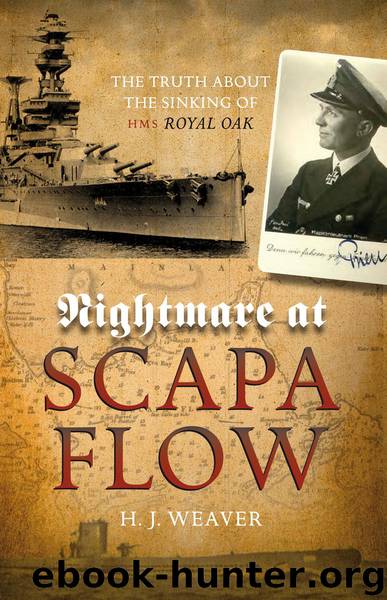Nightmare at Scapa Flow: The Truth About the Sinking of HMS Royal Oak by H J Weaver

Author:H J Weaver [Weaver, H J]
Language: eng
Format: epub, pdf
Tags: History, World War II, Submarines
ISBN: 9780857905185
Publisher: Cressrelles Publishing
Published: 1980-07-15T05:00:00+00:00
8
Flowers for a Fallen Hero
The first of two separate reports produced by the Board of Inquiry – one on the entry of a German submarine, the other on the sinking of Royal Oak – began uncompromisingly: ‘We have obtained no evidence that a submarine was seen or heard entering or leaving the Flow.’ Nor, said the Board, had any trace of a submarine been found subsequently. The survivors’ evidence suggested, however, that the explosions had been caused by torpedoes fired in one or two salvoes, and the claim by Bandmaster Owens to have seen a submarine was considered accurate.
‘We are definitely of opinion therefore that HMS Royal Oak was sunk by torpedoes fired from a submarine,’ the Board went on. ‘Though it is possible that the submarine entered the Flow prior to the night of October 13–14, this is considered unlikely.’
After listing the 11 possible ways a U-boat might have entered the Flow (see Appendix B) and making the point that no lookout was kept at any of the eastern Sounds, the Board continued: ‘The weather on the night of October 13–14 was fine and clear and the sea calm. The night was fairly light and for periods the sky was lit up by the Aurora and Northern Lights. High water at Kirk Sound was at 2338 on October 13 . . . Any opinion as to which entrance the submarine came in at must be conjecture only, but in many respects Kirk Sound would present the least difficulty. Having found a way in, the submarine would no doubt aim to return by the same route, but if it entered by Kirk Sound at slack water and left as soon as the torpedoes were fired the tide would then have been running against it perhaps as much as eight knots’ [note: Board’s emphasis].
The Board next went on to say, not without justification, that it considered ‘the whole problem of the defences of Scapa required reconsideration’ and it recommended a series of measures, most of which Commodore Dönitz, in understandable innocence, had assumed to be already in existence – an adequate force of patrol vessels, asdic defences for boom gates when they were open, minefields, blocking of the eastern entrances, closure as far as possible of the gaps at the sides of booms, lookouts, guns, searchlights, and the extension of boom nets as close to the seabed as was feasible without damaging them.
The whole question of the arrangements for the defence of Scapa Flow that were made prior to the outbreak of war is complex – so complex that a separate sub-committee was appointed to consider the matter before Mr Churchill made his second statement to the Commons about the loss of Royal Oak – but the Board now turned its attention to the vulnerability of the eastern Sounds. ‘The general feeling at Scapa,’ it said, ‘was that the eastern entrances to the Flow were considered by the Admiralty to be satisfactorily closed. Local opinion was no doubt influenced by Admiralty message 1546/May 26.
Download
Nightmare at Scapa Flow: The Truth About the Sinking of HMS Royal Oak by H J Weaver.pdf
This site does not store any files on its server. We only index and link to content provided by other sites. Please contact the content providers to delete copyright contents if any and email us, we'll remove relevant links or contents immediately.
| Africa | Americas |
| Arctic & Antarctica | Asia |
| Australia & Oceania | Europe |
| Middle East | Russia |
| United States | World |
| Ancient Civilizations | Military |
| Historical Study & Educational Resources |
Room 212 by Kate Stewart(4734)
The Crown by Robert Lacey(4572)
Endurance: Shackleton's Incredible Voyage by Alfred Lansing(4503)
The Iron Duke by The Iron Duke(4120)
The Rape of Nanking by Iris Chang(4022)
Killing England by Bill O'Reilly(3897)
Joan of Arc by Mary Gordon(3782)
Say Nothing by Patrick Radden Keefe(3725)
I'll Give You the Sun by Jandy Nelson(3271)
Shadow of Night by Deborah Harkness(3173)
Hitler's Monsters by Eric Kurlander(3164)
Mary, Queen of Scots, and the Murder of Lord Darnley by Alison Weir(3063)
Blood and Sand by Alex Von Tunzelmann(3055)
Darkest Hour by Anthony McCarten(3018)
Margaret Thatcher: The Autobiography by Thatcher Margaret(2970)
Eleanor & Park by Rainbow Rowell(2943)
Red Famine: Stalin's War on Ukraine by Anne Applebaum(2816)
Book of Life by Deborah Harkness(2717)
The One Memory of Flora Banks by Emily Barr(2684)
